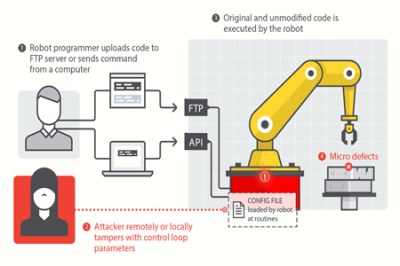Everything is online these days creating the perfect storm for cyber shenanigans. Sadly, even industrial robotic equipment is easily compromised because of our ever increasingly connected world. A new report by Trend Micro shows a set of attacks on robot arms and other industrial automation hardware.
This may not seem like a big deal but image a scenario where an attacker intentionally builds invisible defects into thousands of cars without the manufacturer even knowing. Just about everything in a car these days is built using robotic arms. The Chassis could be built too weak, the engine could be built with weaknesses that will fail far before the expected lifespan. Even your brake disks could have manufacturing defects introduced by a computer hacker causing them to shatter under heavy braking. The Forward-looking Threat Research (FTR) team decided to check the feasibility of such attacks and what they found was shocking. Tests were performed in a laboratory with a real in work robot. They managed to come up with five different attack methods.
 Attack 1: Altering the Controller’s Parameters
Attack 1: Altering the Controller’s Parameters
The attacker alters the control system so the robot moves unexpectedly or inaccurately, at the attacker’s will.
- Concrete Effects: Defective or modified products
- Requirements Violated: Safety, Integrity, Accuracy
 Attack 2: Tampering with Calibration Parameters
Attack 2: Tampering with Calibration Parameters
The attacker changes the calibration to make the robot move unexpectedly or inaccurately, at the attacker’s will.
- Concrete Effects: Damage to the robot
- Requirements Violated: Safety, Integrity, Accuracy
Why are these robots even connected? As automated factories become more complex it becomes a much larger task to maintain all of the systems. The industry is moving toward more connectivity to monitor the performance of all machines on the factory floor, tracking their service lifetime and alerting when preventive maintenance is necessary. This sounds great for its intended use, but as with all connected devices there are vulnerabilities introduced because of this connectivity. This becomes especially concerning when you consider the reality that often equipment that goes into service simply doesn’t get crucial security updates for any number of reasons (ignorance, constant use, etc.).
For the rest of the attack vectors and more detailed info you should refer to the report (PDF) which is quite an interesting read. The video below also shows insight into how these type of attacks might affect the manufacturing process.
Continue reading “Industrial Robots, Hacking And Sabotage” →
















